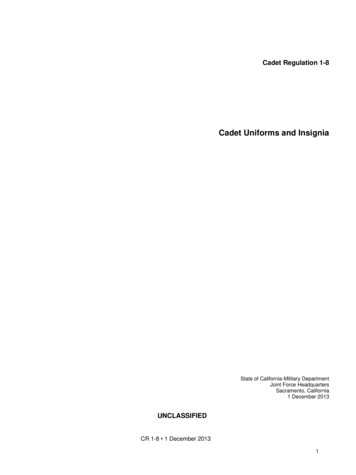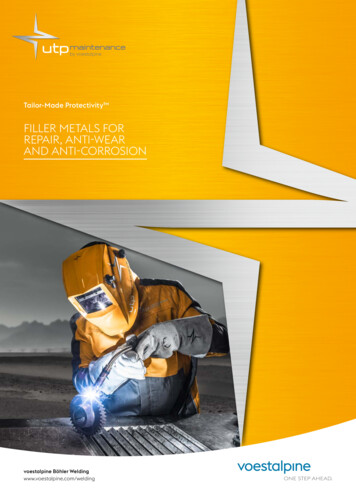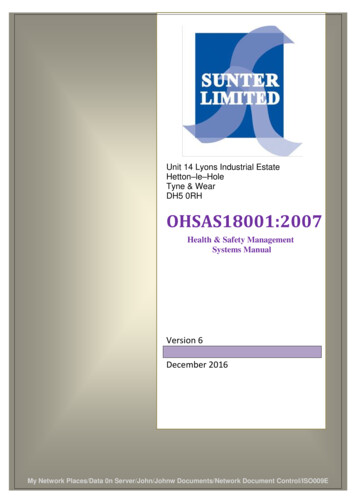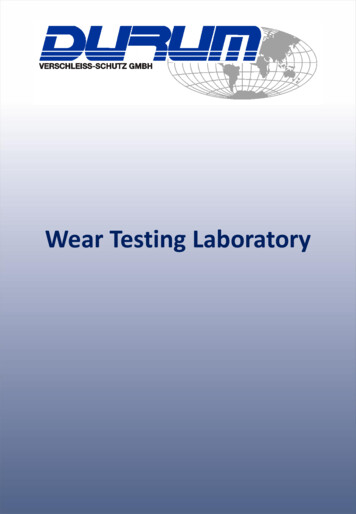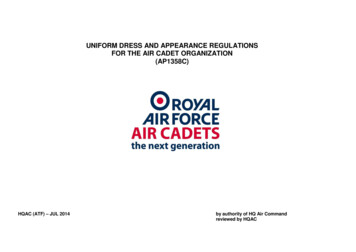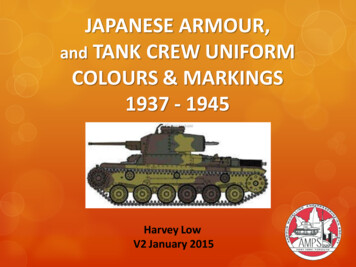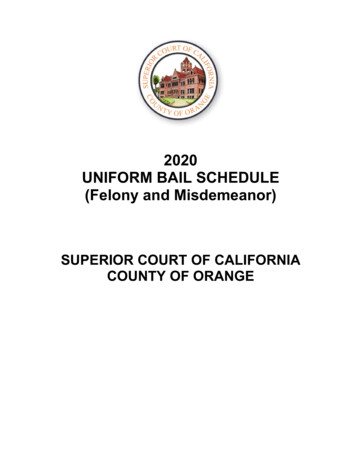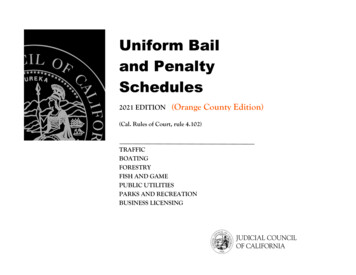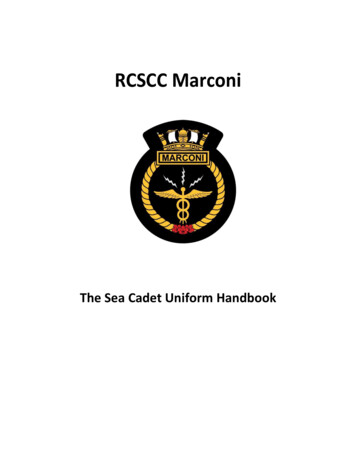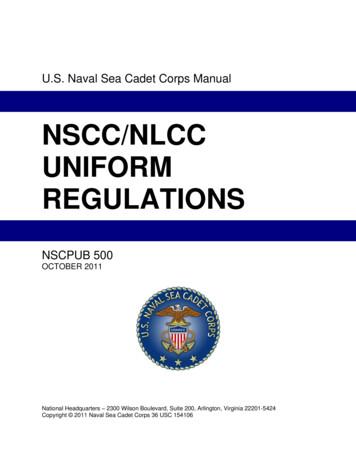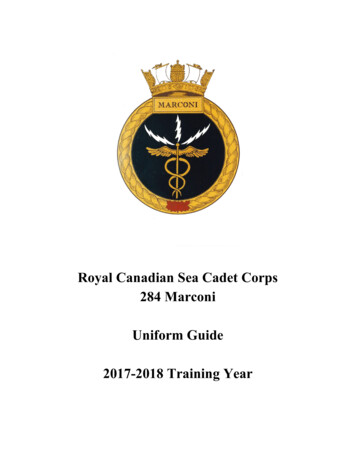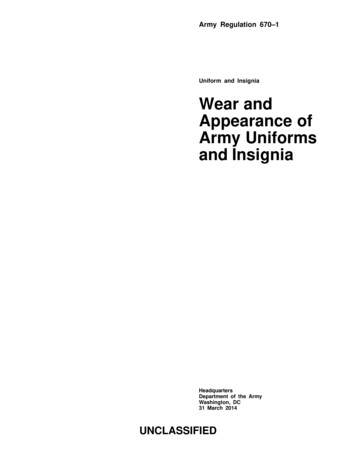
Transcription
Army Regulation 670–1Uniform and InsigniaWear andAppearance ofArmy Uniformsand InsigniaHeadquartersDepartment of the ArmyWashington, DC31 March 2014UNCLASSIFIED
SUMMARY of CHANGEAR 670–1Wear and Appearance of Army Uniforms and InsigniaThis major revision, dated 31 March 2014-oNotifies Soldiers of which portions of the regulation are punitive andviolations of these provisions may subject offenders to adverseadministrative action and/or charges under the provisions of the Uniform Codeof Military Justice (paras 1-5a, 3-2, 3-3, 3-4, 3-5, 3-7, and 3-10).oRemoves Army Ideas for Excellence Program (para 1-6a).oUpdates Responsibilities for The Institute of Heraldry (para 2-3), ProgramExecutive Officer, Program Executive Office Soldier, and U.S. Army NatickSoldier Research, Development and Engineering Center (para 2-4).oUpdates the hair and fingernail standards and grooming policies for males andfemales (para 3-2).oUpdates tattoo and brand policy (para 3-3).oUpdates jewelry policy to limit gauging size to 1.6mm (para 3-4(d)) and addingprohibited dental ornamentation (para 3-4f).oUpdates policy of the wear of Army uniforms at national, regional, and localevents (para 3-5).oUpdates policy on use of electronic devices while in uniform (para 3-6).oUpdates policy on wear of combat uniform on commercial flights (para 3-7c).oUpdates policy on hand carried and shoulder bags (3-7f).oUpdates policy on eyeglasses, sunglasses, and contact lenses (para 3-10).oUpdates the policy on wear of identification tags (para 3-11a).oAdds the combat uniform (para 4-1).oAdds the aircrew uniform (para 6-1).oUpdates service uniforms (chaps 13, 14, and 15).oUpdates policy on umbrella use (para 20-27).oAdds wear of shoulder sleeve insignia-former wartime service for OperationNew Dawn, Operation Enduring Freedom-Philippines, and future operations(para 21-17).oUpdates criteria for overseas service bar (para 21-29).
oAdds the gold star lapel button (para 22-6).oDeletes all procedural guidance regarding uniforms, insignia, and otheruniform accessories (see DA Pam 670-1 (throughout)).oSupersedes AR 600-82, The U.S. Army Regimental System, dated 5 June 1990(throughout).oUpdates policy to remove the battle dress uniforms, white service uniform (toinclude white service cap), and black mess and evening mess uniforms fromauthorized wear (throughout).oMakes additional administrative changes (throughout).oThe following all Army activity messages have been superseded by thisrevision: ALARACT 445/11 Wear of Army Uniform at National, Regional, andLocal Events, dated 7 December 2011; ALARACT 435/2011 Units Authorized toWear the Airborne Tab with the Shoulder Sleeve Insignia, dated 30 November2011; ALARACT 362/2011 Changes to Wear of the Army Combat Uniform (ACU) Items,dated 22 September 2011; ALARACT 315/2011 Authorization to Wear the UniversalCamouflage Patterned (UCP) Flame Resistant (FR) Army Combat Uniforms (ACU)(FR ACU) Upon Redeployment, dated 22 August 2011; ALARACT 241/2011 ModifyingWear of Improved Physical Fitness Uniform (IPFU)dated 23 June 2011; ALARACT239/2011 Request for Exception to Policy to Publish ALARACT Modifying Wear ofImproved Physical Fitness Uniform(IPFU),dated 23 June 2011; ALARACT 230/2011Changes to Wear of the Army Combat Uniform (ACU) Items, dated 17 June 2011;ALARACT 173/2011 Combat Service Identification Badge (CSIB), dated 26 April2011; ALARACT 099/2011 Update ALARACT Message 202/2008 Army Service Uniform,dated 16 March 2011; ALARACT 002/2011 Shoulder Sleeve Insignia-Former WartimeService and Overseas Service Bars-Operation New Dawn, 5 January 2011; ALARACT332/2010 Service Dress Tropical (Class B with Ribbons) Uniform, dated 28October 2010; ALARACT 203/2010 Changes to the Wear Policy for theIdentification Badges Outlined in AR 670-1, paragraph 29-18, dated 1 July2010; ALARACT 199/2010 Shoulder Sleeve Insignia-Former Wartime Service (SSIFWTS) Wear Policy, dated 29 June 2010; ALARACT 183/2010 Directorate ofEvaluation and Standardization (DES) Brassard, dated 17 June 2010; ALARACT178/2010 Changes to the Wear Policy for Other Services Logo Patches Worn asShoulder Sleeve Insignia-Former Wartime Service (SSI-FWTS), dated 17 June2010 (Continued).
oThe following additional all Army activity messages have been superseded bythis revision: ALARACT 177/2010 Army Aircrew Combat Uniform (A2CU) WearPolicy, dated 11 June 2010; ALARACT 178/2010 Changes to the Wear Policy forOther Services Logo Patches Worn as Shoulder Sleeve Insignia-Former WartimeService, dated 11 June 2010; ALARACT 283/2009 Changes to the Wear Policy forthe Chaplains Branch Insignias Worn on the Army Combat Uniform (ACU), 14October 2009; ALARACT 302/2008 Wear Policy for the Generation III ExtendedCold Weather Clothing System (ECWCS), dated 17 December 2008; ALARACT 252/2008 Temporary Wear Policy for the Shoulder Sleeve Insignia (SSI)-CurrentOrganization for the Sustainment Brigades, dated 27 October 2008; ALARACT220/2008 Exception to Policy for Wear of the Enhanced Hot Weather Battle DressUniform (EHWBDU), Aviation Battle Dress Uniform (ABDU), Aviation Flight Suit,and Accessory Items, dated 12 September 2008; ALARACT 202/2008 Army ServiceUniform (ASU) Wear Policy, dated 20 August 2008; ALARACT 195/2008 RequestChange to AR 670-1 For Wear Of The Chemical, Biological, Radiological, andNuclear (CBRN) Insignia, dated 11 August 2008; ALARACT 154/2008 Woodland andDesert Aircrew Battle Dress Uniforms (ABDU(S)) and Green and Tan One-PieceFlight Suits, dated 23 June 2008; ALARACT 149/2008 Changes to the MilitaryPolice (MP) Brassard Wear Policy Outlined In AR 670-1, paragraph 28-29b(9)(A)and (B), dated 17 June 2008; ALARACT 138/2008 Request to Deviate from CurrentPolicies Governing Wear and Furnishing of Civilian Uniforms as Outlined in AR670-1, chapter 30, dated 3 June 2008; ALARACT 100/2008 AR 670-1, Wear andAppearance of Army Uniforms and Insignia (Gold Star Lapel Pin), dated 22January 2008; ALARACT 008/2008 AR 670-1, Wear and Appearance of Army Uniformsand Insignia (Gold Star Lapel Pin), dated 4 April 2008; ALARACT 004/2008Military Uniforms and Accessories Wear Out Dates, dated 8 January 2008;ALARACT 286/2007 AR 670-1 Wear and Appearance of Army Uniforms and Insignia,dated 14 December 2007; ALARACT 226/2007 AR 670-1 Wear and Appearance of ArmyUniforms and Insignia, dated 16 October 2007; ALARACT 186/2007 Uniform WearPolicy Changes for Soldiers Assigned to the Warrior Transition Units, dated23 August 2007; ALARACT 140/2007 AR 670-1 Wear and Appearance of Army Uniformsand Insignia, dated 19 June 2007 (Continued).
oThe following additional all Army activity messages have been superseded bythis revision: ALARACT 055/2007 AR 670-1 Wear and Appearance of Army Uniformsand Insignia, dated 28 March 2007; ALARACT 041/2007 U.S. Army Logo Patch, 7March 2007; ALARACT 220/2006 AR 670-1 Wear and Appearance of Army Uniforms andInsignia, dated 16 November 2006; ALARACT 164/2006 Wear Policy for Flags Wornon Army Combat Uniform, the Army Combat Uniform Patrol Cap, and the Beret,dated 21 September 2006; ALARACT 136/2006 100 Percent Cotton Foliage Green TShirt, dated 12 July 2006; ALARACT 030/2006 Shoulder Sleeve Insignia (SSI)and Shoulder Sleeve Insignia-Former Wartime Service (SSI-FWTS); dated 6February 2006; ALARACT 007/2006 Army Combat Uniform (ACU), dated 12 January2006; ALARACT 17/2006 AR 670-1, 3 FEB 05, Wear and Appearance of Army Uniformsand Insignia (Chapter 1-8, paragraph e, Tattoo Policy), dated 25 January2006; ALARACT 007/2006 Army Combat Uniform (ACU), dated 25 January 2006;ALARACT 164/2006 Wear Policy for Flags Worn on the Army Combat Uniform (ACU),the ACU Patrol Cap, and the Beret, dated 6 September 2006; ALARACT 136/2006100 Percent Cotton Foliage Green T-Shirt, dated 12 July 2006; ALARACT 030/2006 Shoulder Sleeve Insignia (SSI) and Shoulder Sleeve Insignia-FormerWartime Service (SSI-FWTS), dated 06 February 2006; ALARACT 030/2006 ShoulderSleeve Insignia (SSI) and Shoulder Sleeve Insignia-Former Wartime Service(SSI-FWTS), dated 06 February 2006; ALARACT 017/2006 AR 670-1, 3 FEB 05, Wearand Appearance Of Army Uniforms and Insignia (Chapter 1-8, Paragraph E,Tattoo Policy), dated 25 January 2006; ALARACT 007/2006 Army Combat Uniform(ACU), dated 12 January 2006; ALARACT 218/2005 Change to the Army CombatUniform (ACU), Battle Dress Uniform (BDU), and Desert Battle Dress Uniform(DBDU) Wear Policy, dated 26 October 2005; ALARACT 127/2005 Wear andAppearance of Army Uniforms and Insignia, AR 670-1, paragraph 29-60, dated 28June 2005; and ALARACT 078/2005 Army Combat Uniform (ACU) Ensemble, dated 22April 2005.
*Army Regulation 670–1HeadquartersDepartment of the ArmyWashington, DC31 March 2014Effective 30 April 2014Uniform and InsigniaWear and Appearance of Army Uniforms and Insigniauniform regulations do not include sufficient guidance or instruction. It does notapply to the Chief of Staff of the Army,or former Chiefs of Staff of the Army,each of whom may prescribe his or herown uniform. Portions of this regulationare punitive. Violation of the specific prohibitions and requirements of specific portions by Soldiers may result in adverseadministrative and/or charges under theUniform Code of Military Justice.History. This publication is a majorrevision.Summary. This regulation prescribesDepartment of the Army policy for properwear and appearance of Army uniformsand insignia, as worn by officers and enlisted personnel of the Active Army andthe United States (U.S.) Army Reserve, aswell as by former Soldiers.Applicability. This regulation applies tothe Active Army, the Army NationalGuard/Army National Guard of the UnitedStates, and the U.S. Army Reserve, unlessotherwise stated. In addition, it applies tothe Reserve Officers’ Training Corps andthe Corps of Cadets, United States Military Academy, only when their respectiveContentsProponent and exception authority.The proponent of this regulation is theDeputy Chief of Staff, G–1. The proponent has the authority to approve exceptions or waivers to this regulation that areconsistent with controlling law and regulations. The proponent may delegate thisapproval authority, in writing, to a division chief within the proponent agency orits direct reporting unit or field operatingagency in the grade of colonel or the civilian equivalent. Activities may request awaiver to this regulation by providing justification that includes a full analysis ofthe expected benefits and must includeformal review by the activity’s seniorlegal officer. All waiver requests will beendorsed by the commander or seniorleader of the requesting activity and forwarded through their higher headquartersto the policy proponent. Refer to AR 2530 for specific guidance.Army internal control process. Thisregulation contains internal control provisions in accordance with AR 11-2 andidentifies key internal controls that mustbe evaluated (see appendix B).Supplementation. Supplementation ofthis regulation and establishment of command and local forms are prohibited without prior approval from the Deputy Chiefof Staff, G–1 (DAPE–HRI), 300 ArmyPentagon, Washington, DC 22310-0300.Suggested improvements. Users areinvited to send comments and suggestedimprovements on DA Form 2028 (Recommended Changes to Publications andBlank Forms) directly to Deputy Chief ofStaff, G–1 (DAPE–HRI), 300 Army Pentagon, Washington, DC 22310-0300.Distribution. This publication is available in electronic media only and is intended for command levels A, B, C, D,and E for the Active Army, the ArmyNational Guard/Army National Guard ofthe United States, and the U.S. ArmyReserve.(Listed by paragraph and page number)Chapter 1Introduction, page 1Purpose 1–1, page 1References 1–2, page 1Explanation of abbreviations and terms 1–3, page 1Responsibilities 1–4, page 1Statutory Authority 1–5, page 1Recommending changes to Army uniforms 1–6, page 1Classification of service and combat/utility/field uniforms 1–7, page 1*This regulation supersedes AR 670–1, dated 3 February 2005.AR 670–1 31 March 2014UNCLASSIFIEDi
Contents—ContinuedChapter 2Responsibilities, page 1Deputy Chief of Staff, G–1 2–1, page 1Deputy Chief of Staff, G–4 2–2, page 2The Institute of Heraldry 2–3, page 2Program Executive Officer, Program Executive Office Soldier and U.S. Army Natick Soldier Research, Developmentand Engineering Center 2–4, page 2Director and Chief Executive Officer, U.S. Army and Air Force Exchange Service 2–5, page 3Commanders 2–6, page 3Soldiers 2–7, page 3Chapter 3Appearance and Grooming Policies, page 4Personal appearance policies 3–1, page 4Hair and fingernail standards and grooming policies 3–2, page 4Tattoo, Branding, and Body Mutilation Policy 3–3, page 10Jewelry 3–4, page 12Wear of Army uniform at national, regional, and local events 3–5, page 12Uniform appearance and fit 3–6, page 13Required or prohibited wearing of the Army uniform 3–7, page 13Distinctive uniforms and uniform items 3–8, page 15Civilian clothing 3–9, page 15Eyeglasses, sunglasses, and contact lenses 3–10, page 15Identification tags and security identification badges 3–11, page 16Personal protective or reflective clothing 3–12, page 16Organizational protective or reflective clothing 3–13, page 16Heraldic items 3–14, page 16Chapter 4Combat Uniform, page 17Authorization for wear 4–1, page 17Composition 4–2, page 17Occasions for wear 4–3, page 17Chapter 5Maternity Work Uniform, page 18Authorization for wear 5–1, page 18Composition 5–2, page 18Occasions for wear 5–3, page 18Chapter 6Aircrew Uniform, page 18Authorization for wear 6–1, page 18Composition 6–2, page 18Occasions for wear 6–3, page 19Chapter 7Hospital Uniform-Male, page 19Authorization for wear 7–1, page 19Composition 7–2, page 19Occasions for wear 7–3, page 19Chapter 8Hospital and Maternity Uniforms-Female, page 19Authorization for wear 8–1, page 19Composition 8–2, page 20iiAR 670–1 31 March 2014
Contents—ContinuedOccasions for wear 8–3, page 20Chapter 9Food Service Uniform-Male, page 20Authorization for wear 9–1, page 20Composition 9–2, page 20Occasions for wear 9–3, page 20Chapter 10Food Service and Maternity Uniforms-Female, page 21Authorization for wear 10–1, page 21Composition 10–2, page 21Occasions for wear 10–3, page 21Chapter 11Combat Vehicle Crewman Uniform, page 21Authorization for wear 11–1, page 21Composition 11–2, page 21Occasions for wear 11–3, page 21Chapter 12Physical Fitness Uniform, page 22Authorization for wear 12–1, page 22Composition 12–2, page 22Occasions for wear 12–3, page 22Chapter 13Service/Dress Uniform-Male, page 23Authorization for wear 13–1, page 23Composition 13–2, page 23Occasions for wear 13–3, page 23Chapter 14Service/Dress Uniform-Female, page 23Authorization for wear 14–1, page 23Composition 14–2, page 23Occasions for wear 14–3, page 24Chapter 15Maternity Service Uniform, page 24Authorization for wear 15–1, page 24Composition. 15–2, page 24Occasions for wear 15–3, page 24Chapter 16Blue Mess Uniforms-Male, page 25Authorization for wear 16–1, page 25Composition. 16–2, page 25Occasions for wear 16–3, page 25Chapter 17Blue Mess Uniforms-Female, page 26Authorization for wear 17–1, page 26Composition 17–2, page 26Occasions for wear 17–3, page 26AR 670–1 31 March 2014iii
Contents—ContinuedChapter 18White Mess Uniforms-Male, page 26Authorization for wear 18–1, page 26Composition 18–2, page 26Occasions for wear 18–3, page 27Chapter 19White Mess Uniforms-Female, page 27Authorization for wear 19–1, page 27Composition 19–2, page 27Occasions for wear 19–3, page 27Chapter 20Uniform Accessories, page 28General 20–1, page 28Belts and buckles 20–2, page 28Boots 20–3, page 28Buttons 20–4, page 28Capes (officers only) 20–5, page 28Chaplain’s apparel 20–6, page 28Coats, all-weather (male and female) 20–7, page 28Cover, cap, rain 20–8, page 28Cuff links and studs 20–9, page 28Cummerbunds (male and female) 20–10, page 28Gloves 20–11, page 28Handbags 20–12, page 28Hat, drill sergeant 20–13, page 28Judge’s apparel 20–14, page 28Military police accessories 20–15, page 29Neckgaiter 20–16, page 29Neck tabs, female 20–17, page 29Neckties, male 20–18, page 29Overcoat, ceremonial, blue. 20–19, page 29Overshoes, black 20–20, page 29Scarves 20–21, page 29Shirts, white 20–22, page 29Shoes 20–23, page 29Socks 20–24, page 29Suspenders 20–25, page 29Sweaters 20–26, page 29Umbrella 20–27, page 29Undergarments 20–28, page 29Vest, male 20–29, page 29Windbreaker 20–30, page 30Chapter 21Wear of Insignia and Accouterments, page 30General 21–1, page 30General description 21–2, page 30Headgear insignia 21–3, page 30U.S. Insignia 21–4, page 30Grade insignia for general officers 21–5, page 30Grade insignia for other officers 21–6, page 30Grade insignia for enlisted personnel 21–7, page 30Other grade insignia 21–8, page 30ivAR 670–1 31 March 2014
Contents—ContinuedBranch insignia 21–9, page 30Branch insignia-other 21–10, page 31Insignia for aides 21–11, page 31Branch insignia-how worn 21–12, page 31Insignia for U.S. Military Academy staff 21–13, page 32Branch insignia-officer candidates 21–14, page 32Insignia for warrant officer candidates 21–15, page 32Shoulder sleeve insignia-current organization 21–16, page 32Shoulder sleeve insignia–former wartime service 21–17, page 33Wear of U.S. flag embroidered insignia 21–18, page 35Branch colors 21–19, page 35Branch scarves 21–20, page 35Leaders identification insignia 21–21, page 35Distinctive unit insignia 21–22, page 36Regimental Distinctive Insignia 21–23, page 37Insignia Representing Regimental Affiliation 21–24, page 37Insignia, distinguishing, U.S. Army nametape and nameplate. 21–25, page 37Aiguillette, service 21–26, page 37Aiguillette, dress 21–27, page 37Service stripes 21–28, page 37Overseas service bars 21–29, page 37Brassards 21–30, page 39Distinctive items authorized for infantry personnel 21–31, page 39Distinctive items authorized for other than infantry personnel 21–32, page 39Chapter 22Wear of Decorations, Service Medals, Badges, Unit Awards, and Appurtenances, page 40General 22–1, page 40Authorization 22–2, page 40When wearing awards is prohibited 22–3, page 40Order of precedence by category of medal 22–4, page 40Order of precedence within categories of medals 22–5, page 41Wear of service ribbons and lapel buttons 22–6, page 41Full-sized U.S. and foreign decorations and service medals 22–7, page 41Miniature decorations and service medals 22–8, page 41Multiple neck ribbons, broad sashes, and stars 22–9, page 41U.S. and foreign unit awards 22–10, page 41Appurtenances 22–11, page 42Badges authorized for wear on Army uniforms 22–12, page 42Badges not authorized for wear on Army uniforms 22–13, page 44Categories of badges authorized for wear on Army uniforms 22–14, page 44Marksmanship badges and tab 22–15, page 44Combat and special skill badges 22–16, page 44Identification badges 22–17, page 44Foreign badges 22–18, page 44Chapter 23Wear of the Army Uniform by Reserve, Retired, Separated, and Civilian Personnel, page 44Occasions of ceremony 23–1, page 44Army National Guard and U.S. Army Reserve 23–2, page 45Retired personnel 23–3, page 45Former members of the Army 23–4, page 46Medal of Honor recipients 23–5, page 46Medals on civilian clothes 23–6, page 46Prohibition on uniform wear 23–7, page 46AR 670–1 31 March 2014v
Contents—ContinuedUniform similar to the Army uniform 23–8, page 47Distinctive unit insignia on civilian clothing 23–9, page 47Uniforms worn by United States civilians 23–10, page 47AppendixesA.References, page 48B.Internal Control Evaluation, page 51Figure ListFigure 3–1: Male Grooming Standards, page 7Figure 3–2: Prohibited Male Haircuts, page 8Figure 3–3: Female Hairstyle Standards, page 9GlossaryviAR 670–1 31 March 2014
Chapter 1Introduction1–1. PurposeThe Army is a profession. A Soldier’s appearance measures part of his or her professionalism. Proper wear of theArmy uniform is a matter of personal pride for all Soldiers. It is indicative of esprit de corps and morale within a unit.Soldiers have an individual responsibility for ensuring their appearance reflects the highest level of professionalism.Leaders, at all levels, have a responsibility for implementing and applying the standards contained in this regulation toensure the best interests of the Army, including our shared traditions and customs. This regulation prescribes theauthorization for wear, composition, and classification of uniforms, and the occasions for wearing all personal (clothingbag issue), optional, and commonly worn organizational clothing and individual equipment uniforms. It prescribes theuniforms, awards, insignia, and accouterments authorized for wear. It also provides general information on theauthorized material and design of uniforms and the uniform quality control system.1–2. ReferencesSee appendix A.1–3. Explanation of abbreviations and termsSee the glossary. The descriptive definitions for the following terms are in the glossary and provide aid in theunderstanding of this regulation: eccentric, fad(dish), exaggerated, conservative, inconspicuous, unsightly, extreme,braids/plaits (hair).1–4. ResponsibilitiesSee chapter 2 for responsibilities.1–5. Statutory Authoritya. Portions of this regulation are punitive. Violation of the specific prohibitions and requirements of specificportions by Soldiers may result in adverse administrative action and/or charges under the provisions of the UCMJ.b. Only uniforms, accessories, and insignia prescribed in this regulation, or in the common table of allowance(CTA), or as approved by Headquarters, Department of the Army (HQDA), will be worn by personnel in the U.S.Army. Unless specified in this regulation, the commander issuing the clothing and individual equipment will establishwear policies for organizational clothing and individual equipment. No item governed by this regulation will be alteredin any way that changes the basic design, or the intended concept of fit, as described in Technical Manual (TM)10–227 and Army Regulation (AR) 700–84, including plating, smoothing, or removing detailed features of metal items,or otherwise altering the color or appearance.c. AR 70–1 prescribes Department of the Army (DA) policies, responsibilities, and administrative procedures bywhich all clothing and individual equipment used by Army personnel are initiated, designed, developed, tested,approved for acquisition, fielded, and modified.d. AR 385–10 prescribes DA policies, responsibilities, and administrative procedures and funding for protectiveclothing and equipment.e. In accordance with Section 771, Chapter 45, Title 10, United States Code, no person except a member of the U.S.Army may wear the uniform, a distinctive part of the uniform, or any part of which is similar to a distinctive part ofthe U.S. Army uniform, unless otherwise authorized by law. Soldiers are not authorized to wear distinctive uniforms oruniform items of the U.S. Army or of other U.S. Services with or on civilian clothes, except as authorized by thisregulation.1–6. Recommending changes to Army uniformsSee DA Pam 670–1 for recommending changes to Army uniforms.1–7. Classification of service and combat/utility/field uniformsSee DA Pam 670–1 for classification of uniforms.Chapter 2Responsibilities2–1. Deputy Chief of Staff, G–1The DCS, G–1 will—a. Develop and publish the following Army policies:b. Function as a member of the Army Uniform Board, which is established in accordance with AR 70–1.AR 670–1 31 March 20141
c. Coordinate with Army and Air Force Exchange Service and the DCS, G–4, as required, to incorporate uniformchanges or additions to this regulation and/or DA Pam 670–1.2–2. Deputy Chief of Staff, G–4The DCS, G–4 will—a. Be responsible for the life cycle management of clothing and individual equipment, in accordance with AR 70–1.b. Coordinate the Army Uniform Board meetings in accordance with AR 70–1.2–3. The Institute of HeraldryTIOH will—a. Monitor the Heraldic Quality Control Program in accordance with AR 672–8, to ensure heraldic items aremanufactured according to Government specifications or purchase descriptions.b. Provide manufacturers with Government-loaned tools and specifications for heraldic items.c. Authorize the manufacture of heraldic items and issue certificates of authority to manufacture items in accordancewith the provisions of AR 672–8.d. Approve designs for distinctive unit insignia (DUI), regimental distinctive insignia (RDI), shoulder sleeve insignia(SSI), flags, and badges, as authorized by this regulation.e. Prepare and maintain specifications, manufacturing drawings and purchase descriptions for insignia worn on theArmy uniforms.2–4. Program Executive Officer, Program Executive Office Soldier and U.S. Army Natick SoldierResearch, Development and Engineering CenterPEO Soldier and Project Manager, Soldier Protection and Individual Equipment, in conjunction with the NSRDEC, areresponsible for the Uniform Quality Control Program (UQCP). PEO Soldier and NSRDEC will—a. Prepare and maintain military specifications, purchase descriptions, and master patterns for optional uniformitems, as recommended by the Army Uniform Board and approved by the Chief of Staff, Army in accordance with AR70–1.b. Publish and disseminate periodic bulletins to industry that provide guidance and information regarding changes inmilitary specifications, testing and certification requirements, uniform regulations, or adoption of new optional uniformitems.c. Furnish specifications, purchase descriptions, master patterns, shade standards, and other information aboutoptional uniforms to industry, when required.d. Receive and examine laboratory test reports, manufacturer certifications, and samples from commercial manufacturers, custom tailors, military tailors, and other suppliers of optional uniform items, as required. Require manufacturersto provide requested laboratory test reports, manufacturer certifications, and samples of optional uniform items at nocost to the Army.e. Issue certificates of authority to manufacturers whose samples meet or exceed standards established by specifications of purchase descriptions. Certificates will be supplemented by documents showing the specific optional uniformitems that the manufacturer is authorized to produce. Provide a list of certified manufacturers and products that will befurnished to the U.S. Army and Air Force Exchange Service and posted on appropriate Army Web sites. Revoke orsuspend certificates when the certificate holder has violated any of the expressed conditions under which the certification was granted, as determined by PEO Soldier.f. Conduct inspections and otherwise monitor manufacturers for compliance with certificate terms and conditions.Review optional uniform items to verify compliance with, or appropriate exemption/waiver from, applicable domesticsource requirements as set forth in Section 2533a, Chapter 148, Title 10, United States Code (10 USC Chapter 148,Section 2533a).g. Coordinate with designated service points of contact to ensure that outside continental United States producedoptional uniform items are evaluated and approved prior to being sold within theater to Soldiers. Outside continentalUnited States Army service component commands will establish service points of contact to direct local textile anduniform producers desiring to sell optional uniform items to Soldiers to NSRDEC for coordination.h. Ensure manufacturers and suppliers of optional uniform items do the following:(1) Obtain certification required under the UQCP from NSRDEC or Project Manager (Soldier Protection andIndividual Equipment) before manufacturing any optional uniform items for sale.(2) Affix a label with the following information certifying the optional uniform items were manufactured inaccordance with the UQCP prior to offering the items for sale: This item is warranted to meet or exceed the standardsof specification number and was produced under certificate number from basic material warranted by the manufactureras having been produced in accordance with the sample under current certification. This item is not authorized for turnin to central issue facilities.(3) Familiarize themselves with Army specifications, purchase descriptions, testing/certification requirements, shade2AR 670–1 31 March 2014
standards, and other pertinent information for optional uniform items, and submit required samples and information toNSRDEC or Project Manager (Soldier Protection and Individual Equipment) for approval.(4) Comply with all terms of the certification. Certificates may be revoked or suspended if the certificate holder hasviolated any of the expressed conditions of the certification.2–5. Director and Chief Executive Officer, U.S. Army and Air Force Exchange ServiceDirector and Chief Executive Officer, U.S. Army and Air Force Exchange Service will—a. Operate, manage, and supervise the Military Clothing Stores (MCS) Program worldwide, in accordance with theterms of a memorandum of understanding between DA and U.S. Army and Air Force Exchange Service, Dallas, Texas.b. Be responsible for the control, storage, and distribution of “issue” MCS inventories and optional-wear militaryclothing items from certified manufacturers, according to DA specifications and as developed by PEO Soldier, 5901Putnam Road, Building 328, Fort Belvoir, VA 22060–5852, in conjunction with the textile technology team at theNatick Soldier Center, Natick, MA 01760. (Optional-wear items are those not considered “issue” items.) Responsibilitydoes not include war reserve stock management.2–6. Commandersa. Commanders of Army commands (ACOM)/Army service component commanders (ASCC)/direct reporting unit
SUMMARY of CHANGE AR 670–1 Wear and Appearance of Army Uniforms and Insignia This majo
